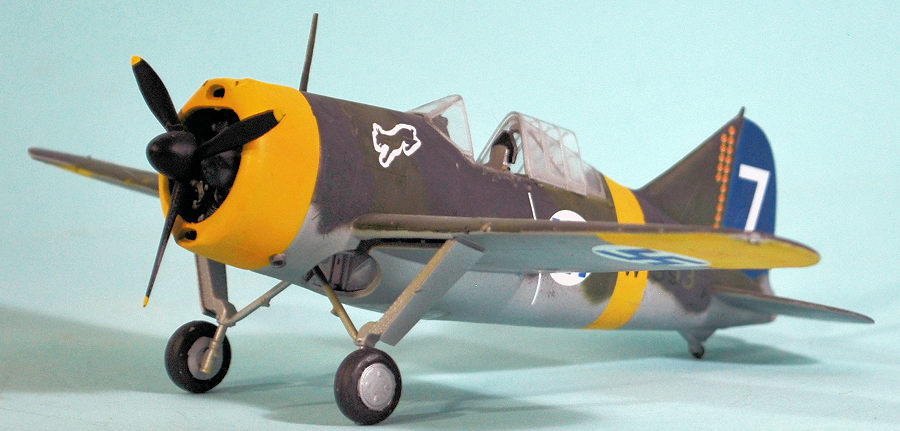
| KIT #: | SH 48180 |
| PRICE: | $16.98 |
| DECALS: | Three options |
| REVIEWER: | Tom Cleaver |
| NOTES: | ex-Classic Airframes kit |

| HISTORY |
How a company that produced buggies during the 19th Century and was virtually moribund before it was bought, resuscitated, and turned into a manufacturer of naval aircraft managed with its first design - the B-239 - to come in ahead of Grumman, the company that was rapidly becoming the Navy’s premier aircraft designer, is one of those mysteries of military procurement that will never be fully known. That this failure of a company, which continued to fail in producing its products as they were ordered by its customer of choice, and that this happened in the days before there were any MBAmorons to blame, is a chapter of American commerce worthy of a U.S. History doctoral dissertation somewhere.
Be all that
as it may, the Brewster B-239 - designated F2A by the Navy - did in fact become
the first all metal monoplane fighter with an enclosed cockpit and retractable
landing gear to be ordered by the U.S. Navy to equip its fleet squadrons. While
the resulting airplane did indeed come with perhaps more than its share of
mechanical and technical faults, its sorry reputation in combat is due to
government decisions that put poorly-trained, inexperienced pilots in its
cockpits, then sent them into combat against an enemy whose pilots were among
the best-trained and most-experienced in the world at that time, than any
intrinsic failing of the airplane. A pilot like N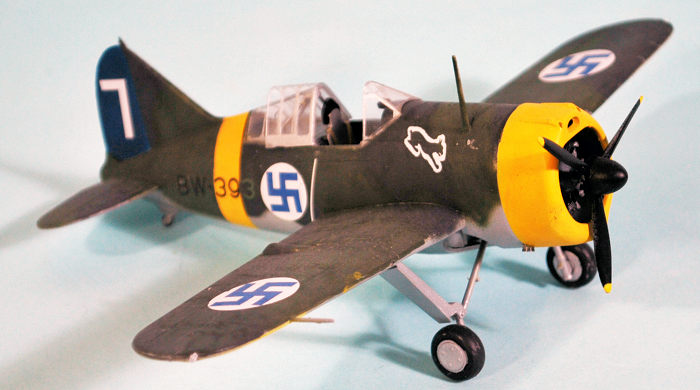 ew Zealand’s Geoff Fisken, who
had accumulated sufficient hours in the Buffalo - as the F2A was known to the
RAF - by the expedient of being assigned as the delivery pilot flying them to
newly-equipped squadrons, was able to put his knowledge of what the airplane
could and could not do to advantage against that highly-experienced enemy, and
become an “ace” in the skies over Singapore at the outset of the Pacific War;
two other Buffalo pilots with less knowledge of the airplane than Fisken had
also achieved that status. No less an authority than Marine legend Marion Carl -
who had experience with the F2A-3, the version with the worst performance - once
said that had he and his fellow Marines at Guadalcanal been flying the F2A-3
rather than the Grumman F4F-4, and used the same tactics they did with the
Wildcat, “the results would have been about the same.” As poor a performer as
the F2A-3 was, it was not that far behind the too-heavy, underpowered F4F-4,
suffering only a more fragile landing gear than its more robust stablemate,
while having a longer range and an armament that provided more firing time due
to a larger ammo load.
ew Zealand’s Geoff Fisken, who
had accumulated sufficient hours in the Buffalo - as the F2A was known to the
RAF - by the expedient of being assigned as the delivery pilot flying them to
newly-equipped squadrons, was able to put his knowledge of what the airplane
could and could not do to advantage against that highly-experienced enemy, and
become an “ace” in the skies over Singapore at the outset of the Pacific War;
two other Buffalo pilots with less knowledge of the airplane than Fisken had
also achieved that status. No less an authority than Marine legend Marion Carl -
who had experience with the F2A-3, the version with the worst performance - once
said that had he and his fellow Marines at Guadalcanal been flying the F2A-3
rather than the Grumman F4F-4, and used the same tactics they did with the
Wildcat, “the results would have been about the same.” As poor a performer as
the F2A-3 was, it was not that far behind the too-heavy, underpowered F4F-4,
suffering only a more fragile landing gear than its more robust stablemate,
while having a longer range and an armament that provided more firing time due
to a larger ammo load.
What the Brewster B-239 was capable of in the hands of well-trained, experienced pilots, was shown in the skies over Finland between June 1941 and August 1944, producing 36 aces with a force that numbered only 44 B-239s at the outset.
In the face of Soviet territorial demands, the Finnish government contacted the U.S. government in April 1939, seeking to acquire modern combat aircraft as quickly as possible. Rapid availability and compatibility with 87-octane fuel were the only requirements. Transfer of “rejected” aircraft was approved in accordance with the Neutrality Act on October 17, 1939, helped by a publicity campaign emphasizing that Finland was the only country that had repaid its World War I debts to the U.S. By this time, Brewster was finally delivering its fighter, but the Navy was already becoming disillusioned with the company and its product, especially since Grumman had persisted with their F4F which was now close to entering production and service. Thus, the Navy was happy to declare the 44 F2A-1s “rejected for service,” allowing their transfer to Finland.
On December 16, 1939, the Finns signed a contract to purchase 44 Model 239 fighters. The total agreed price was U.S. $3.4 million, for 44 airplanes, spare parts, ten replacement engines and 20 spare Hamilton Standard propellers. The F2A-1s had all naval equipment such as tail hooks and life-raft containers removed. The B-239s, as they were now known,lacked self-sealing fuel tanks and cockpit armor. They were equipped with an export-approved Wright R-1820-G5 950 hp radial engine. After delivery, the Finnish Air Force added armored backrests, metric flight instruments, the Väisälä T.h.m.40 gunsight, and four 12.7 mm machine guns. Top speed of the Finnish B-239s, as modified, was 297 mph.
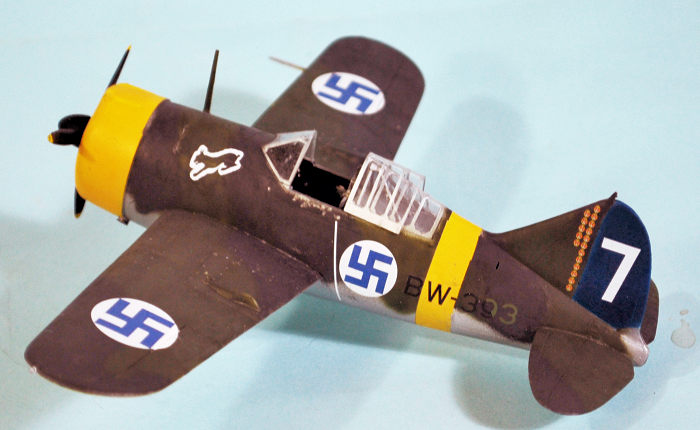 The B-239s
were shipped in four batches to Bergen, Norway, in January and February 1940.
They were then sent by rail to Sweden and assembled by Saab at Trollhättan.
Finnish Air Force pilot Lieutenant Jorma Karhunen flight tested the first B-239
in February 1940; due to lack of familiarity, he burned out the engine while
flying very low at high speed and crashed on a snow-covered field, damaging the
propeller and some belly panels. Finnish pilots were initially unimpressed, but
changed their minds when they saw a demonstration by a Brewster test pilot,
during which he was able to stay on the tail of a Finnish Fiat G.50 Freccia
fighter; although the G.50 was faster in level flight, the B-239 could out-turn
it.
The B-239s
were shipped in four batches to Bergen, Norway, in January and February 1940.
They were then sent by rail to Sweden and assembled by Saab at Trollhättan.
Finnish Air Force pilot Lieutenant Jorma Karhunen flight tested the first B-239
in February 1940; due to lack of familiarity, he burned out the engine while
flying very low at high speed and crashed on a snow-covered field, damaging the
propeller and some belly panels. Finnish pilots were initially unimpressed, but
changed their minds when they saw a demonstration by a Brewster test pilot,
during which he was able to stay on the tail of a Finnish Fiat G.50 Freccia
fighter; although the G.50 was faster in level flight, the B-239 could out-turn
it.
The Brewster B-239 was never referred to as the "Buffalo" in Finland. It was known as the "Brewster" or by the nicknames “Taivaan Helmi” ("Sky Pearl") or “Pohjoisten Taivaiden Helmi” ("Pearl of the Northern Skies"). Other nicknames were Pylly-Valtteri,("Butt-Walter" - from the “BW” in the Finnish serial) and “Amerikanrauta” ("American hardware" or "American car") and “Lentävä Kaljapullo” ("Flying Beer-Bottle").
The B-239s were regarded as being easy to fly, a "gentleman's traveling plane," and was popular because of its relatively long range and good maintenance record. Finnish mechanics solved a problem that plagued the Wright Cyclone engine by inverting one of the piston rings in each cylinder, which increased reliability. The cooler weather of Finland also helped, because the engine was prone to overheating as noted in tropical Pacific use.
By the time the Continuation War began with Finland as an ally of Germany, the pilots of Lentolaivue 24 (LeLv 24) had a year’s experience with the B-239. The B-239s of LeLv 24 claimed 477 victories for the combat loss of 19, a victory ratio of 26:1. Most of the pilots were Winter War combat veterans. The Brewsters had their baptism by fire on June 25, 1941, when a pair from 2/LLv24 intercepted 27 Tupolev SB-2s from 201st SBAP over Turku, claiming five shot down. Finnish pilots used basic tactics against less well-trained Soviet opponents. The default was the four-plane "parvi" (swarm), with one pair flying lower as bait, with a higher pair to dive on any enemy engaged. Their opposition was Polikarpov I-152 and I-153 biplanes and I-6 monoplanes. The Soviet northern forces did not begin to operate more modern fighters until 1943, when American P-39s and P-40s had arrived in Murmansk, while some Yak-1 and LaGG-3-equipped units were transferred to the northern sector of the Eastern Front. The top-scoring B-239 pilot was Hans Wind with 39 kills.
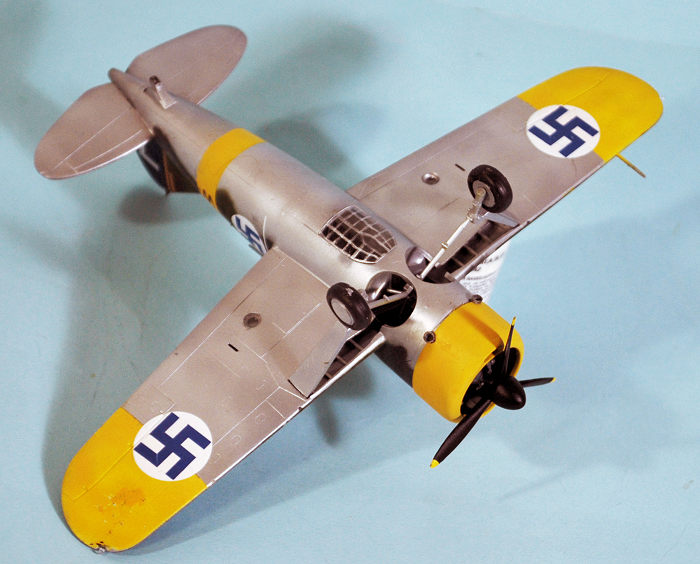 Eino
Luukkanen:
Eino
Luukkanen:
Eino Luukkanen was one of the top-scoring aces, and perhaps the best combat leader in the Finnish Air Force during what was known to the Finns as The Continuation War.
Luukkanen joined the air force became a pilot officer in a cadet school course in 1931, graduating and commissioned an Ensign in 1933. Posted to the 1st Maritime Squadron in Viipuri, hee flew both as pilot and observer. In 1935, he was transferred to fighter squadron LeLv 26, equipped with the Bristol Bulldog Mk.IV. Promoted to Captain in 1939, he was posted as commander of the 3rd flight of Fighter Squadron 24 (LeLv24), which had just equipped with the Fokker D.XXI fighter.
Luukkanen scored his first victory, a Soviet Tuplolev SB-2 bomber, on the second day of what became known as The Winter War, on December 1, 1939. By the end of the war in March 1940, he had shot down a second SB-2 and shared the shoot-down of a Pol8ikarpov R-5 bomber. Immediately after the end of the war, he was one of the pilots who ferried the 44 newly-arrived Brewster B0-239 fighters from Trollhättan, Sweden to Finland. LeLv 24 re-equipped with the fighter, and training started immediately.
Luukkanen scored five victories in 1941 and nine more in 1942. In January 1942, he became the youngest squadron commander in the air force when he took command of H/LeLv 30, the air force’s tactical reconnaissance unit. His B-239 was notable for the victory score on the vertical fin, which was recorded with labels of Lahden Erikois beer bottles.
| THE KIT |
This kit by Special Hobby originally appeared in 2004-05, released by Classic Airframes. It was re-released by Special Hobby in 2008 following the demise of Classic Airframes. It is the only kit available in 1/48 of the original F2A-1/B-239.
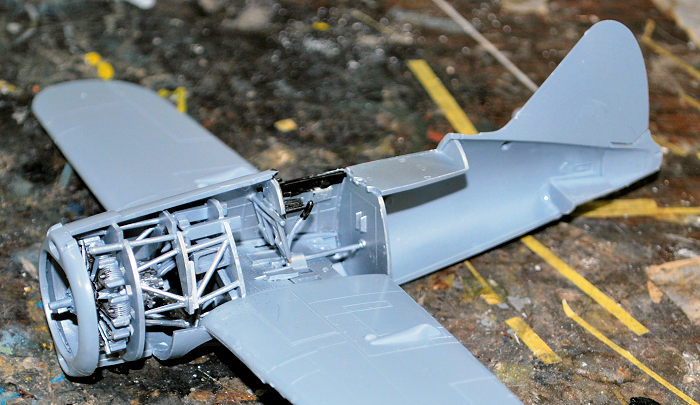 The kit has
all-engraved panel lines, a correct fuselage and cowling for the F2A-1, parts
for an injection-molded engine mount and resin wheel well detail - none of which
is particularly visible once the fuselage is assembled, even using a penlight.
The cockpit is well-detailed and includes the armored seat the Finns used.
Photoetch detail is provided for the instrument panels and seat belts. Decals
are provided for two aircraft, one of which is shown in its earlier markings
when flown by Luukkanen and when it was later flown by top B-239 ace Hans Wind.
The canopy is injection plastic and is quite clear. Unlike many injection
canopies, it is easy to set the sliding part open to display the cockpit.
The kit has
all-engraved panel lines, a correct fuselage and cowling for the F2A-1, parts
for an injection-molded engine mount and resin wheel well detail - none of which
is particularly visible once the fuselage is assembled, even using a penlight.
The cockpit is well-detailed and includes the armored seat the Finns used.
Photoetch detail is provided for the instrument panels and seat belts. Decals
are provided for two aircraft, one of which is shown in its earlier markings
when flown by Luukkanen and when it was later flown by top B-239 ace Hans Wind.
The canopy is injection plastic and is quite clear. Unlike many injection
canopies, it is easy to set the sliding part open to display the cockpit.
The kit is not up to the modern Special Hobby standards, and needed a couple applications of Mr. Surfacer 500 on the fuselage centerline and the cowling ring to get a final smooth finish.
| CONSTRUCTION |
There is really no easy way to assemble this kit, as Scott Van Aken conclusively demonstrated in his review of the Classic Airframes release of this kit. The instructions would have you assemble the wings - which involves using the resin wing ribs that really don’t want to fit - and then attach the firewall, the engine mount and the gas tank to this sub-assembly, then assemble the cockpit to the two fuselage halves, then fit the fuselage around the engine mount and close things up. All in all, very fiddly. I chose to do all that assembly with one fuselage half glued in position to the wing sub-assembly, then attach the other fuselage half once all the interior was done. While this might sound more difficult, it was actually much easier than following the kit suggestion, as I did when I did a C-A kit 15 years ago.
| COLORS & MARKINGS |
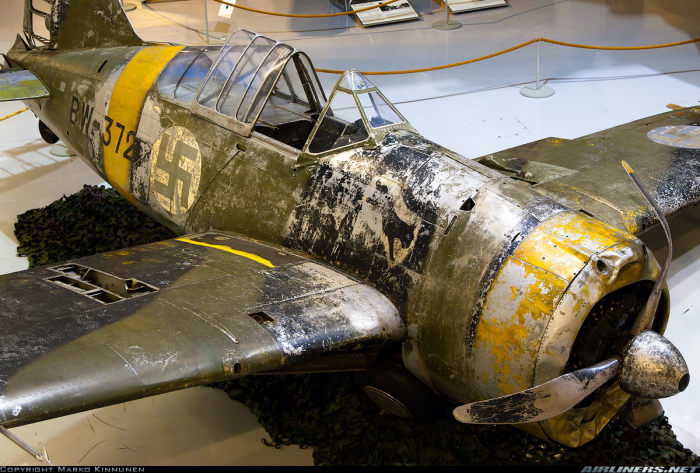 There has
been considerable information come out about the painting of the Finnish B-239s
since one was pulled out of a lake and examined. What follows is the best
information available on these airplanes:
There has
been considerable information come out about the painting of the Finnish B-239s
since one was pulled out of a lake and examined. What follows is the best
information available on these airplanes:
The B-239s were originally delivered in an overall aluminum lacquer, with the fabric control surfaces painted aluminum dope. When they were camouflaged and marked for the Continuation War, the camouflage paint was applied directly over the aluminum paint, without a further primer. The underside was left in aluminum lacquer, with the yellow areas of the outer wingtip painted over the original paint again without primer. The area around the cockpit canopy was left in aluminum lacquer.
By late 1942, this finish was getting worn. The semigloss aluminum lacquer had gone dead flat due to the weather extremes - this shows up in black and white photos as gray, which is why some said the airplanes were repainted with gray lower surfaces. In fact, only a few were repainted when they were repaired from combat. These airplanes were stripped, primered, and repainted with the Oliver Green/Black upper surface camouflage, while the lower surface was painted with a blue close to RLM 65. The other airplanes were never repainted until after the war, when they were reconditioned and saw continued limited use until the early 1950s.
B-239s known to have been repainted are BW-388, 363, 386, 377, 371, 366, 392, 379, 354, 374 and 365 during 1942. BW-367, 356, 364, 387, 375, 357, 384, 361 and 353 were reconditioned in 1943 and BW-368, 373, 384, 361 and 353 in 1944.
The cockpit of the B-239 was painted at Brewster in aluminium lacquer, with the upper sections of the sidewalls on both sides painted black, as was the instrument panel and the forward coaming. During major overhauls, the aluminum areas of the interiors were repainted light gray.
When doing
research for one of these airplanes, the following “rule of thumb” can be used
in photo analysis: if the upper surface paintwork is very tatty, the
undersurfaces are likely in the original aluminum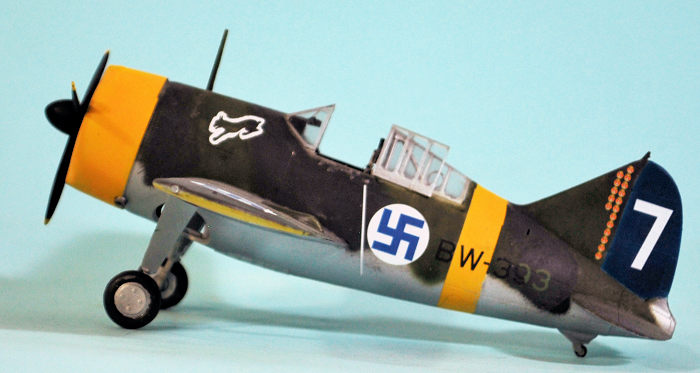 lacquer with the Swedish
style serials painted about mid-wing. However, some airplanes had the serial
removed from the lower wing without being repainted. If the paintwork is good
and the Finnish style serials are present, that probably means the undersurfaces
are the later RLM 65 equivalent.
lacquer with the Swedish
style serials painted about mid-wing. However, some airplanes had the serial
removed from the lower wing without being repainted. If the paintwork is good
and the Finnish style serials are present, that probably means the undersurfaces
are the later RLM 65 equivalent.
Fortunately, Special Hobby has paid attention to all this, and the painting and markings instructions in the kit are accurate.
I painted this model overall aluminum, using Tamiay XF-16 “Flat Aluminum” thinned with Microcoat Gloss 50-50. I then painted the yellow markings with Tamiya XF-3 Flat Yellow, with some orange added to get the equivalent of RLM 04 “Gelb” and masked them off. I freehanded the upper surface with Tamiya XF-58 “Olive Green” and XF-60 “NATO Black.”
I used the kit decals for the individual aircraft markings, and Finnish insignia from the Eduard Finnish 109s special release, since these were thick enough that the white background was fully opaque.
I attached the lower clear part, the landing gear and prop, and the sliding canopy in the open position.
| CONCLUSIONS |
This kit is not for the beginner, but a modeler with a few limited-run kits will have no problem with it if you take your time. Personally, I like the Finnish B-239s because of their story. I had the good fortune back in 2004 to interview one of the last Finnish aces, who still had good memories of the hours he spent in the cockpit of “The Brewster.” The record of the airplane shows that it’s the man in the cockpit that makes the difference in any combat.
4 February 2021
Copyright ModelingMadness.com. All rights reserved.
Review kit courtesy of Special Hobby
If you would like your product reviewed fairly and fairly quickly, please contact the editor or see other details in the Note to Contributors.
Back to the Main Page Back to the Review Index Page Back to the Previews Index Page